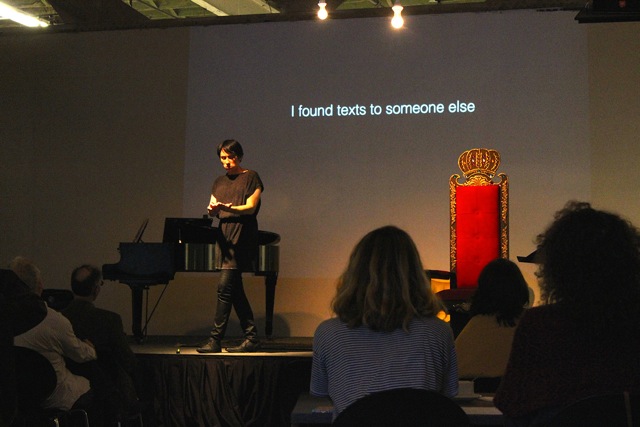
Joseph Keckler brings opera to life with ‘Let Me Die’ at the Museum of Contemporary Art Detroit

“Let Me Die” by Joseph Keckler. Photo by Rosie Sharp.
On Saturday, Dec. 12, performance artist Joseph Keckler staged a four-hour presentation of a work-in-progress, “Let Me Die,” at the Museum of Contemporary Art Detroit. “Let Me Die” is a performance piece incorporating the death scenes from dozens of operas in the public domain (all performed by Keckler, who has an impressive three-octave range), as well as storytelling, video and a great deal of humorous asides. The work-in-progress has been developed intensively as part of Keckler’s residency at University of Michigan Stamps School of Art & Design, during which he collaborated with students in a music video class to create a fully realized and hilarious piece of modern opera, “Strangers From the Internet.” This was just one of many elements of the performance at the Museum of Contemporary Art Detroit, which is the recipient of multiple Knight grants.
I followed up with Keckler with questions about his unusual process and the politics of opera in a modern world.
Do you have a background in opera, or is this a specific subset of performance art? Have you performed any of these operas before? I am a trained singer, yes, though I studied voice during and after a visual art education. I’ve ended up working in a very free way—I write songs, faux-classical arias of a sort, stories, essays and collage-based performances and texts. I have, in fact, been in some operas in the past, though most of the material I’m currently using for this piece is new to me. Recently I acted at Lincoln Center in a piece called “Preludes” by Dave Malloy, where I played the great Russian bass Chaliapin.
The death scenes are obviously hyperbolic moments within a generally hyperbolic form. What attracted you to that? I am primarily interested in language, the way death figures into conversations about opera, or the classics in general—“opera is dead,” or “it’s not dead,” or “the audience is dying,” etc.—and the way it figures into the form. There’s some mirroring going on there. The form itself becomes personified, and I’m working with this personification, treating the form like a character, or like a body. The length of the piece (four hours) is an operatic length, and this aspect of endurance, or duration, in the form works in counterpoint to the content, which is, of course, death…

“Let Me Die” by Joseph Keckler. Photo by Rosie Sharp.
What do you think is at stake in these death scenes? Is it helping you process something more immediate to your life? My interest in the project seems more intellectual to me than personal, although I was in a several-year relationship that ended, and this is coming up. Many times, the characters dying in opera are driven to kill themselves because they cannot be with the person they love, or have been abandoned, because of some troubled relationship. I myself would prefer to die only on stage and not in life, but I am channeling some of that grief.
How has the process of working with the students at Stamps been, and what role do they play in the work or the residency experience? A group of students helped me make a video, “Strangers From the Internet,” which is my version of an operatic reckoning scene, an adaptation of a bit from my previous body of work, “I Am an Opera.” The students have a range of roles—from makeup, to performance, to editing. They also are working on individual music videos that are in dialogue with mine. I also collaborated with a student from the University of Michigan and very active artist in Ann Arbor and Detroit, Niki Voyeur, on a video for a ‘pop’ song of mine, “Kamikaze,” which samples a sequence from Verdi’s “Aida.”
This is the very beginning of “Let Me Die.” I developed the concept over the past year, but have been actively researching and piecing together material mainly only the past three months. It’s in some ways in a nascent state and will continue to take shape in the next couple of years.
Recent Content
-
Artsarticle ·
-
Artsarticle ·
-
Artsarticle ·
